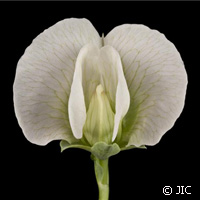Scientists solve Mendel's pea flower colour mystery
Gregor Mendel, the 19th century Augustinian monk and scientist, heralded as the father of modern genetics, used the gene that controls pea flower colour to study the inheritance of certain traits in pea plants. But researchers have been baffled about how trait transmission actually works. Enter an EU-funded team of researchers that has uncovered the mystery behind one of science's most renowned biology experiments. Their latest study, funded in part by the GRAIN LEGUMES ('New strategies to improve grain legumes for food and feed') project, which received nearly EUR 15 million under the 'Food quality and safety' Thematic area of the EU's Sixth Framework Programme (FP6), sheds new light on the underlying molecular genetics behind Mendel's experiment. Led by the John Innes Centre (JIC) in the UK, the researchers compared the pea DNA (deoxyribonucleic acid) sequences to those of other well-characterised plants, identifying the genes that control flower colour in pea plants. 'This was a real collaborative effort, it would not have happened without all of these people participating, especially if Roger [Dr Roger Hellens, Science Leader of the Genomics Group at Plant & Food Research in New Zealand] had not had the enthusiasm to nail a problem that has been bugging him for years,' said Professor Noel Ellis from JIC's Department of Crop Genetics. The purple colour of wild type pea flowers, and flowers of many other plants, is a result of the accumulation of pigment molecules called anthocyanins. The biochemistry of their production has been studied for many years. The study, presented in the journal PLoS ONE, describes two pea genes, known as A and A2, that regulate the production of anthocyanins. 'By comparing the pea DNA sequences to those of other well-characterised plants, such as petunia, we have determined that Mendel's gene is a transcription factor that controls the anthocyanin biosynthesis pathway,' Dr Roger Hellens explained. 'This transcription factor, when mutated, becomes inactive and anthocyanin is not produced, resulting in white flowers.' Around 3,500 pea lines were used by the researchers in the study. The collection housed at the JIC, includes material from wild, cultivated and semi-cultivated sources, some dating back to the 19th century. 'We used information from our previous genotyping of the JIC pea germplasm collection to identify exotic lines where we would most likely find rare alleles of Mendel's gene,' Professor Ellis said. 'Finding a rare second allele was important for independent confirmation of the identity of the gene.' He went on to say that that was 'the fourth of Mendel's seven genes to be characterised at the molecular level: it is also the second where JIC has been involved'. So what's next for the researchers? The JIC in particular is now looking into the germplasm collection for genes and traits that could be used to make peas higher-yielding or of better quality. Peas are able to fix nitrogen from the air through symbiotic relationships with bacteria housed in nodules in their roots. This makes them less dependent on the addition of nitrogenous fertilisers which are a major economic and environmental cost associated with farming because they require high levels of energy for their production. Their use is also a major source of nitrous oxide, a potent greenhouse gas, which along with carbon dioxide and other gases, is blamed for contributing to manmade global warming. The increased production of peas and other legumes is a good way of ensuring future food security with low environmental cost, according to the researchers. Plant scientists from the Biotechnology and Biological Sciences Research Council (BBSRC) in the UK, New Zealand's Plant & Food Research, Unité de Recherche en Génomique Végétale (URGV) in France and the US Department of Agriculture (USDA)'s Agricultural Research Services contributed to the study.
Countries
France, New Zealand, United Kingdom, United States



